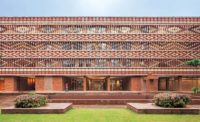Weavers’ shuttles, birdcalls, buzzing bees, and the breeze: these are the sounds that architect Bijoy Jain says a visitor can hear in the protected courtyard of the Ganga Maki Textile Studio. Located in a grove of mangoes in the foothills of the Himalayas, in Bhogpur, India, the studio and factory are composed of a series of four L-shaped volumes arranged in a horseshoe pattern around the courtyard—the heart of the project—where a water trough is positioned to reflect a full moon. Adjacent buildings contain dining facilities and residences for staff and guests, a gallery and store, and a cow barn.
The client, Japanese textile designer Chiaki Maki, discovered the work of Jain’s 20-year-old firm, Studio Mumbai, at an exhibition in Tokyo. She was intrigued. Her previous factory—about 12 miles away from the current site—was too small for her business, and there was no room to expand. At the new 15,000-square-foot studio, which welcomes visitors, Maki and her team of craftspeople ferment their own indigo and produce silk, wool, cotton, and linen textiles, all of which are naturally dyed and woven on-site. “The architecture, its materials, the proportion of the spaces, the type and size of openings, the amount of light and ventilation—all of this has been calibrated in accord with each function,” says Jain.
The buildings are constructed with brick and locally harvested lime, as well as stone, marble, and bamboo. RECORD contributing photographer Iwan Baan, who spent a number of days on-site shooting the complex, says, “Bijoy is always amazing at finding craftsmen who have been doing a specific thing for many years. Every column is a single piece of stone. There’s never a veneer with these buildings—all its components are visible.” While most of the roofs are made of cement sheet or stone, Gallery Ganga Maki has a sawtooth roof fitted with thin, translucent panes of marble, protecting the showroom from harsh sunlight and heat and creating a soft, immersive glow. Jain notes that, in fact, the stone is a more economical solution than traditional glazing in this part of India.
As Baan explains, many of the craftspeople employed by the factory come from generations of skilled textile workers—a teenager he met during his visit is following in his father’s footsteps. “The endeavor,” says Jain, “was to embody and cultivate the cyclical relationship between work and life, and the sun and the moon, bringing together past, present, and future.”











Post a comment to this article
Report Abusive Comment